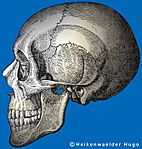Prognathism facts for kids
Prognathism (say: prog-NAY-thiz-um) is a word used to describe when a part of the face, usually the jaw, sticks out more than usual. Think of it like a face that isn't completely flat from top to bottom.
Most humans have what is called an orthognathic (say: or-thog-NAY-thik) face. This means their face is mostly straight up and down, or vertical. However, many other animals, especially other primates like monkeys and apes, have prognathic faces. Their jaws often stick out quite a bit in front of the upper part of their head.
Contents
Types of Prognathism
Prognathism can affect different parts of the face. Doctors and scientists use specific terms to describe exactly which part is sticking out.
Nasal Prognathism
This type of prognathism happens when the area around and including the nose sticks out more than usual. It's also sometimes called upper facial projection. Imagine if the middle part of your face, where your nose is, was pushed forward a bit.
Alveolar Prognathism
Alveolar (say: al-VEE-uh-lar) prognathism refers to when the part of the upper jaw that holds your teeth sticks out. This is often called mid-facial projection. If you have a noticeable "overbite," where your upper front teeth extend far beyond your lower teeth, it's often caused by this type of prognathism.
Mandibular Prognathism
Mandibular (say: man-DIB-yoo-lar) prognathism is when the lower jaw, also known as the mandible, sticks out. This is commonly called an "underbite." In an underbite, your lower front teeth sit in front of your upper front teeth when your mouth is closed.
Images for kids
-
Leopold I, showing prognathism
See also
 In Spanish: Prognatismo para niños
In Spanish: Prognatismo para niños




